So, your asking the question “What guitar scales should I learn?”? Let’s dig in!
Summary
When thinking about what guitar scales you should learn, it can seem very daunting.
There are so many scales out there but there’s lots out there that are standard ones you should really know as a guitarist.
All the scales in western music come from the same origin, the Chromatic Scale.
The Chromatic Scale contains 12 notes.
All other scales then choose a selection of notes from the Chromatic Scale to give a certain sound.
Scales themselves have no real meaning to a listener.
It is the order in which the notes are heard and the harmonic backing to those notes i.e. chords being played that give the notes of a scale their character.
I’ve referred to two types of scales, Diatonic and Pentatonic. The difference being the number of notes in the scale.
Diatonic has seven notes and Pentatonic has 5.
Many guitarists get by with only know the simpler Pentatonic Scales. I recommend you learn the Diatonic Scale versions first and then understand what the Pentatonic is after. It will help you understand where it all fits together.
If you struggle with learning all notes in the Diatonic Scale, then just get your head around the Pentatonic Scale first and fill in the extra notes when you’re ready.
The main article goes into more detail on each scale, but I’ve summarised the scales that I recommend you learn below:
- Major Diatonic Scale;
- Natural Minor Diatonic Scale;
- Major Pentatonic Scale;
- Minor Pentatonic Scale;
- Blues Scale; and
- Mixolydian Scale.
I’ve no recommendation for the key you select, it doesn’t make too much difference. The best way to dive right in is pick a scale that you’ve never heard of.
I’ll give you a few of the standards to
Some scales are linked to each other.
So, learning scales that are linked together would make the most sense to start with.
For example, learning the minor scale than uses the same notes as the related major scale and vice versa. If you learn the C Major Scale, then you’ve pretty much learnt the A Natural Minor Scale.
The only difference is that the notes are either heard in a different order or played against a different harmonically related backing.
Musical scales that guitarists tend to know are:
- C Major Diatonic;
- A Natural Minor Diatonic
- C Major Pentatonic;
- A Minor Pentatonic;
- A Blues Scale
- A Blues Scale
- G Mixolydian Scale
There are obviously more scales you can learn but if you don’t know these then get them under your belt!
I’ve gone into more detail on the theory behind the list of scales and the notes within them I’ve recommended at the start in the Main Article below.
Please feel free to join my free Fret Success Academy on the website.
Read on for the main article.
Hope this helps!
Main Article
So, you want to know what guitar scales you should learn?
(Make sure you just briefly read the summary above first before reading the main article, if you haven’t already)
You’ve picked up some basics or even learned a few songs but want something more.
The most obvious next step in the progression is to start thinking about scales.
You may have heard someone talking about them or just know they exist and that they’re something you should probably think about learning.
The thing is, learning scales is so important!
Asking this question puts you ahead of a lot of people who are happy just reading tab and learning songs without the context of what they’re learning.
That’s fine!
But if you really want to develop as a guitar player you must learn some scales. You’ll thank your past self later for doing so.
It’s easy to get overwhelmed with the massive task of learning all the scales.
But if you learn a few basics then you’ll find learning the rest a lot easier!
Let’s get into these mythical scales then.
Chromatic Scale
The chromatic scale is the master scale.
It’s the scale that contains all the notes we can use in Western Music.
All the other scales just cherry pick a selection from the Chromatic Scale to create a certain sound.
What is the Chromatic scale?
The chromatic scale is a representation of all possible notes in music. It’s an important concept to grasp that musical notes in the chromatic scale are not linear (i.e. in one line) but actually circular in a continuous pattern; increasing in pitch with no start or end point.
Check out the figure below to see all the possible notes in western music.
Each note is a semitone apart, and the smallest amount we can move in music.
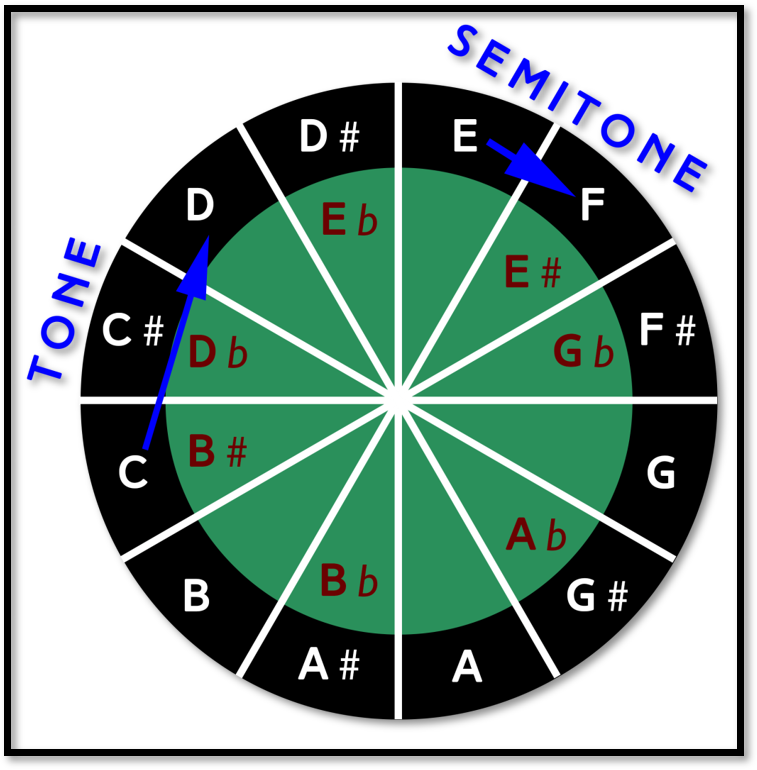
So, let’s learn more of these other scales that come from selecting certain notes from the Chromatic Scale.
For simplicity, I’m going to first list the formula for each scale type and then give a real-life example for the A tonality, i.e. A Major, A Minor etc.
Major Diatonic Scale
What is this scale?
The major scale is one of the simple diatonic scales that all musicians should learn.
Major Scale Formula
It’s really important that you get your first guitar scale under your belt as soon as possible. Scales are very simple to understand, once you grasp the basic concepts. It’s very tempting to put off learning scales but understanding them now makes life so much easier in the long run.
A scale is a set of notes that are related to each other, when played either together or one after each other. The spacing between these notes is known as the ‘interval’ between them, which are normally described as either semi-tones or tones (two semitones).
The best way to think of scales is that we’re picking a grouping from the Chromatic Scale Wheel, which all relate to each other harmonically (i.e. they complement each other when played in sequence).
We need to pick a starting point, which is our “root/tonic” (name) of the scale and then move around the wheel in a set pattern to get the notes of the scale.
The major scale has an associated set of intervals that give it that happy character. The concept to grasp here is that the sound of each note in the chromatic scale does not give the scale its character. It’s actually the intervals between them that do this. Your brain automatically recognises the intervals between the notes and that is the basis of harmonic music.
The intervals for a major scale, starting from the root, are Tone; Tone; Semitone; Tone; Tone; Tone; and Semitone. Each note in the scale is also given a reference name which is the ‘Scale Degree’ i.e. Tonic, Supertonic etc. See the image below to get more of an idea of this.

C Major Scale
The C major scale is the simplest to understand as there are no sharps or flats within it. The figure below shows how the notes in the C Major scale are taken from the chromatic scale of all possible notes. The notes are C, D, E, F, G A, and B; easy to remember right?

C Major Scale Fretboard Example
The fretboard diagram below shows the notes of the C Major Scale, with the yellow notes indicating the root of the scale.
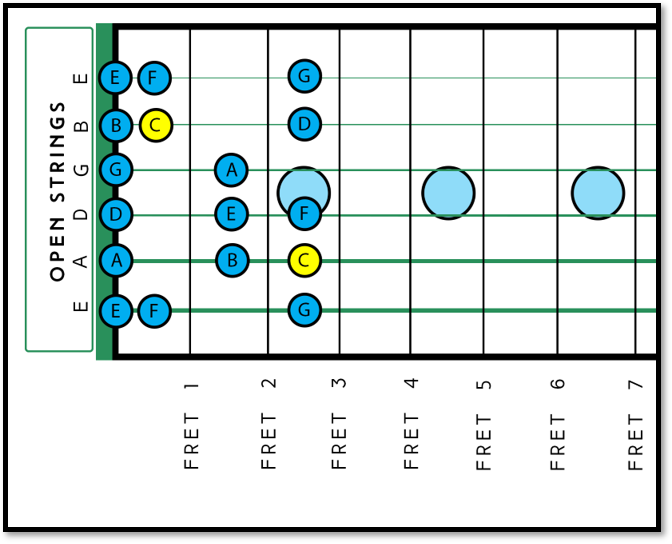
Minor Diatonic Scale
So, let’s talk about Minor Scales!!!
Just like the Major Scale, we need to pick a starting point, which is our “root/tonic” (name) of the scale and then move around the wheel in a set pattern to get the notes of the scale.
The minor scale has an associated set of intervals that give it that unhappy character. The concept to grasp here is that the sound of each note in the chromatic scale does not give the scale its character. It’s actually the intervals between them that do this. Your brain automatically recognises the intervals between the notes and that is the basis of harmonic music.
We’re going to go through the most commonly used Minor Scale, the natural minor.
The intervals for a natural minor scale, starting from the root, are Tone; Semitone; Tone; Tone; Semitone; Tone; and Tone. Each note in the scale is also given a reference name which is the ‘Scale Degree’ i.e. Tonic, Supertonic etc. See the image below to get more of an idea of this.
 A Minor Scale
A Minor Scale
The A minor scale is the simplest to understand as there are no sharps or flats within it. The figure below shows how the notes in the A Minor scale are taken from the chromatic scale of all possible notes. The notes are A, B, C, D, E, F, and G; easy to remember right? Do you notice a similarity with the C Major Scale?
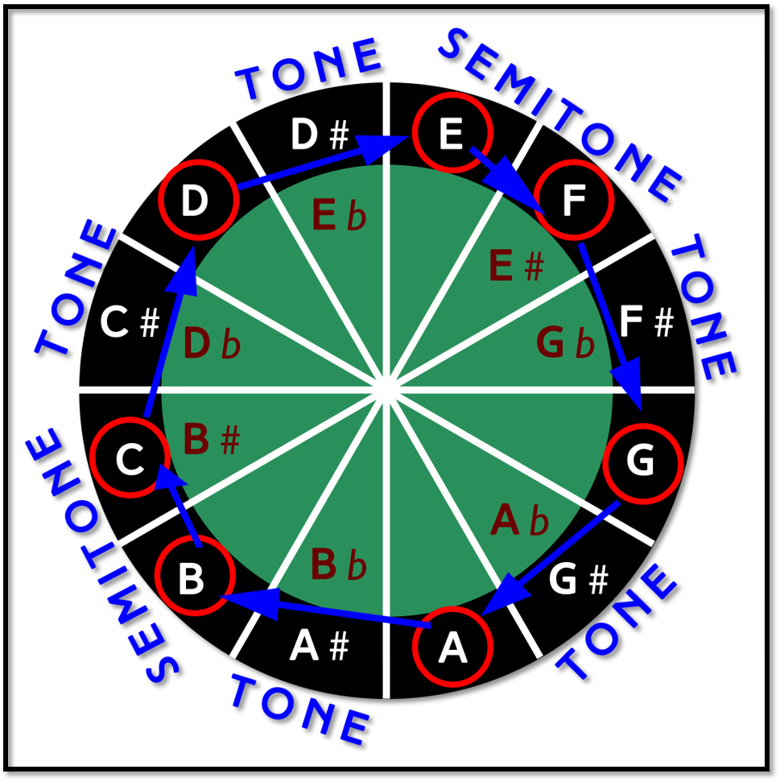
A Minor Scale Fretboard Example
The fretboard diagram below shows the notes of the A Minor Scale, with the yellow notes indicating the root of the scale and blue notes the rest of the scale.
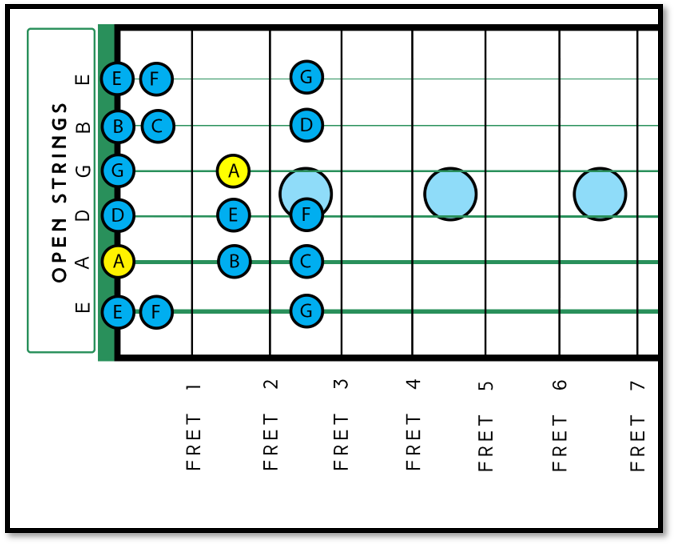
Major Pentatonic Scale
What is this scale?
The major pentatonic is a simpler version of the major scale. So, if you already know the major scale then you probably don’t need to know the pentatonic version. Pentatonic scales are used by beginners or those instances where you’re not too sure what notes to play over a chord progression, taking the dissonant notes out of the equation, i.e. the ones that are harder to fit in harmonically.
The Major Pentatonic is the notes 1, 2, 3, 5, and 6 of the Major Scale.
C Major Pentatonic Scale Notes
In the instance of the C Major Pentatonic Scale, we’re looking at notes C, D, E, G, and A.
C Major Pentatonic Scale Fretboard Example
The fretboard diagram below shows the notes of the C Major Pentatonic Scale. The root notes are in yellow and the rest of the scale in green. The remaining blue notes show the remaining C Major Scale notes that aren’t in the C Major Pentatonic Scale.
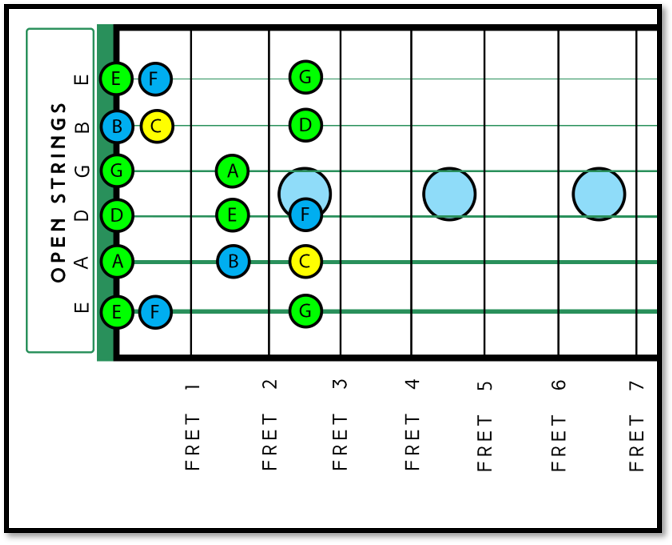
Minor Pentatonic Scale
What is this scale?
The minor pentatonic is a simpler version of the minor scale. So, if you already know the minor scale then you probably don’t need to know the pentatonic version. Pentatonic scales are used by beginners or those instances where you’re not too sure what notes to play over a chord progression, taking the dissonant notes out of the equation, i.e. the ones that are harder to fit in harmonically.
Minor Pentatonic Scale Formula
The Minor Pentatonic is the notes 1, 3, 4, 5, and 7 of the Minor Scale.
A Minor Pentatonic Scale Notes
In the instance of the A Minor Pentatonic Scale, we’re looking at notes A, C, D, E and G.
A Minor Pentatonic Scale Fretboard Example
The fretboard diagram below shows the notes of the A Minor Pentatonic Scale. The root notes are in yellow and the rest of the scale in green. The remaining blue notes show the remaining A Minor Scale notes that aren’t in the A Minor Pentatonic Scale.
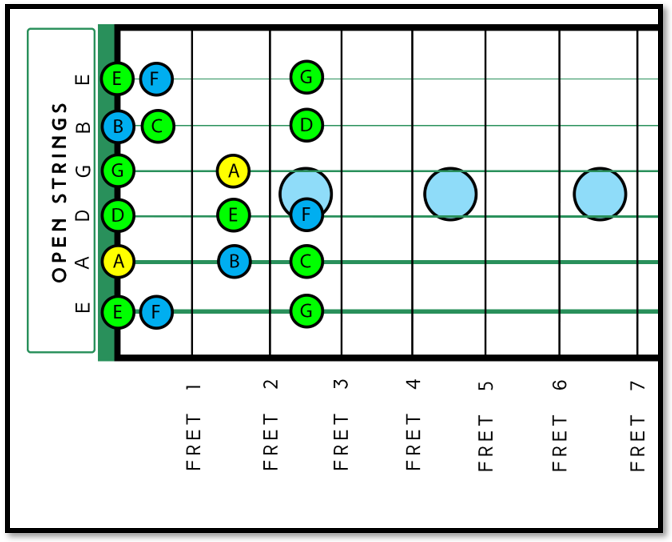
Blues Scale
What is this scale?
The blues scale is probably the next scale that guitarists learn after the basic major and minor scales and their pentatonic versions. It’s a versatile scale in some ways but also has a definite sound to it.
The blues scale is in the middle of the natural minor scale and the minor pentatonic, in that it contains six notes. It is in essence the minor pentatonic scale plus the flattened 5th note of the scale (same for major and minor).
Blues Scale Formula
The Blues Scale contains the notes 1, 3, 4, 5b, 5, and 7 of the Minor Scale.
A Blues Scale Notes
In the instance of the A Blues Scale, we’re looking at notes A, C, D, Eb, E G; with Eb being the flattened 5th note. Flattening a note means to drop it by a semitone on the chromatic scale.
A Blues Scale Fretboard Example
The fretboard diagram below shows the notes of the A Blues Scale. The root notes are in yellow and the rest of the scale in green. The remaining blue notes show the remaining A Minor Scale notes that aren’t in the A Blues Scale for reference.

Mixolydian Scale
What is this scale?
The Mixolydian scale is a very interesting scale and one of my favourites. It’s a very cool scale for adding flavour in the blues style. This is because it has both a major and minor sound depending on the part of the scale you’re in.
Mixolydian Scale Formula and Theory
If we think in terms of the Major scale, the mixolydian scale contains notes 1, 3, 4, 5, 6, and b7. The flattened seventh note is similar to the natural minor scale. If you play through the mixolydian scale in note order you can hear the little nuances of the scale with it’s major and minor flavour.
G Mixolydian Scale Notes
In the instance of the G Mixolydian Scale, we’re looking at notes G, A, B, C, D, E, and F.
G Mixolydian Scale Fretboard Example
The fretboard diagram below shows the notes of the G Mixolydian Scale. The root notes are in yellow and the rest of the scale in blue.
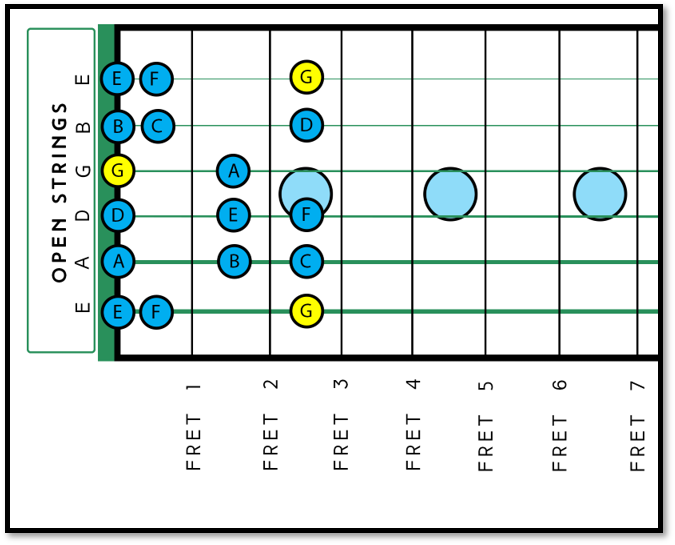
Drop a comment below with your favourite scale from the list, or even one that you’ve been struggling with!
I hope this article has been of use.
I also have lots of free guitar lesson guitar available when you subscribe to the Fret Success Academy.
Thanks,
Dan

(Founder)
www.fretsuccess.com


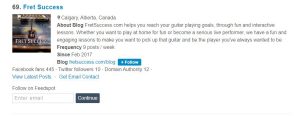








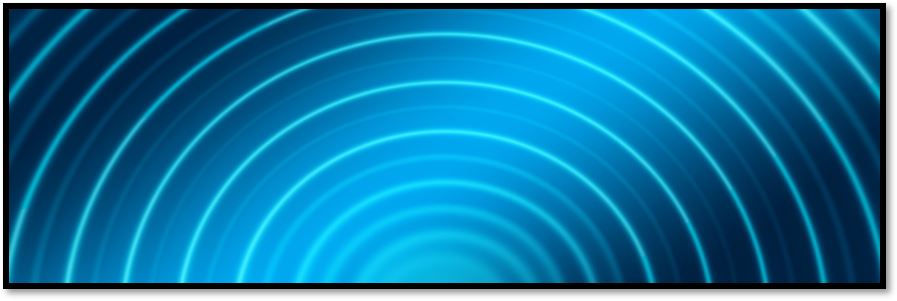

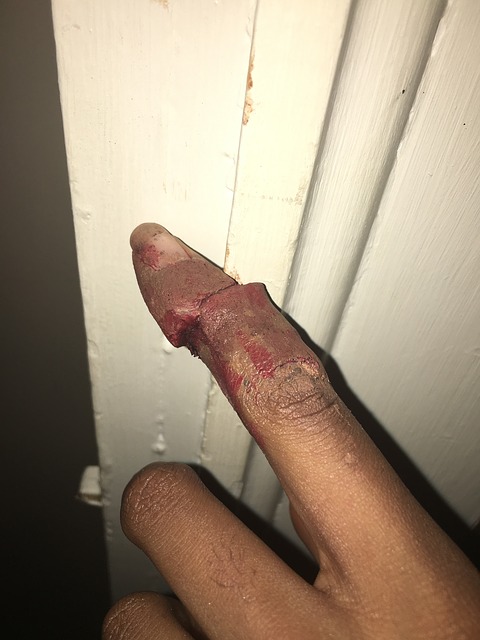
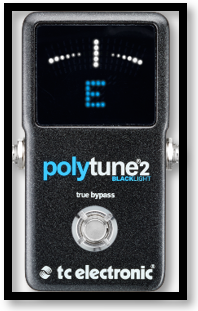







 A Minor Scale
A Minor Scale




